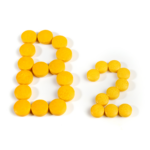
The Verdict:
In a vacuum, riboflavin is not a problematic ingredient. However, if a grain-based product contains riboflavin, the implication is that the grain has been enriched or fortified, which implies the grain is of lower nutritional quality.
What is Riboflavin?
Riboflavin is another name for vitamin B2. It performs necessary functions for enzyme formation. Riboflavin is found naturally in eggs, kidneys, liver, lean meats, milk, and some vegetables.
Why is Riboflavin used?
Riboflavin is commonly used to fortify grain products in the United States. Also, when chemically isolated, it’s an orangish-yellow crystalline powder. This is why it’s also used as food coloring, on occasion.
How is Riboflavin made?
Of course, Riboflavin occurs naturally in the aforementioned foods. Today, riboflavin is manufactured via fermentation. Certain species of molds, yeast and bacteria are natural overproducers of riboflavin, and today most of these microorganisms have been genetically modified to increase their riboflavin output. In earlier periods, riboflavin was also manufactured via a chemical process, but this process is obsolete and is no longer used in a commercial/industrial setting, due to it being far cheaper and more efficient to create it via fermentation.
If you’re someone who is concerned about the consumption of genetically modified organisms, you should be OK to consume riboflavin, even though it is produced with genetically modified yeasts, molds, and bacteria. There is no difference between riboflavin produced by genetically modified yeasts, molds and bacterium when compared to yeasts molds, and bacteria that aren’t genetically modified. Any desire to withhold from eating riboflavin would be based on the desire to not support companies that use genetic engineering technology.
What is the history of Riboflavin?
Riboflavin was discovered by an English Chemist named Alexander Wynter Blyth while analyzing whey in the 1870s. However, it wasn’t characterized as Riboflavin initially, Alexander first named the compound “lactochrome” due to its bright yellow color when exposed to light. In the 1930s, a Hungarian-born American scientist Paul Gyorgy, Austrio-German biochemist Richard Kuhn and Austrian physician Theodor Wagner-Jauregg collaborated to identify and isolate the compound. This was done with lab rats by controlling their diets and determining what vitamins when added or omitted affected growth.
The name “Riboflavin” comes from a merging of two names, ovoflavin and lactoflavin. It had two names because after its discovery, those scientists found a way to isolate the compound from both egg yolks and whey. For its current name, “Ribo” comes from “Ribose” a sugar that when reduced to ribitol forms part of the compound. “Flavin” comes from the biochemical structure called “flavin”, which is derived from the latin word “Flavus” meaning “yellow.” Hence the name, Riboflavin.
Today, the primary global producers of riboflavin are BASF, DSM, Hubei Guangji Pharmaceuticals, and Shanghai Acebright Pharmaceuticals.
Conclusion:
In a vacuum, riboflavin is not a problematic ingredient. Its addition into foods is unnecessary, because a good diet should be receiving more than enough from natural sources. If one does have a vitamin B2 deficiency, it would be more effective to increase the intake of food where it naturally occurs or supplement it directly, as opposed to eating foods that have been enriched or fortified with it. If you see it on a nutrition label, make sure to look at the other ingredients, particularly grains, with more scrutiny.
Sources:
Averianova LA, Balabanova LA, Son OM, Podvolotskaya AB, Tekutyeva LA. Production of Vitamin B2 (Riboflavin) by Microorganisms: An Overview. Front Bioeng Biotechnol. 2020 Nov 12;8:570828. doi: 10.3389/fbioe.2020.570828. PMID: 33304888; PMCID: PMC7693651.
https://www.ncbi.nlm.nih.gov/pmc/articles/PMC7693651
Northrop-Clewes CA, Thurnham DI. The discovery and characterization of riboflavin. Ann Nutr Metab. 2012;61(3):224-30. doi: 10.1159/000343111. Epub 2012 Nov 26. PMID: 23183293.
https://pubmed.ncbi.nlm.nih.gov/23183293
“Riboflavin: Fact Sheet for Health Professionals”. Office of Dietary Supplements, US National Institutes of Health. 11 May 2022. Archived from the original on 24 February 2020. Retrieved 18 April 2024.
https://ods.od.nih.gov/factsheets/Riboflavin-HealthProfessional